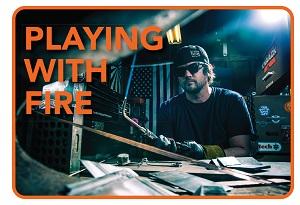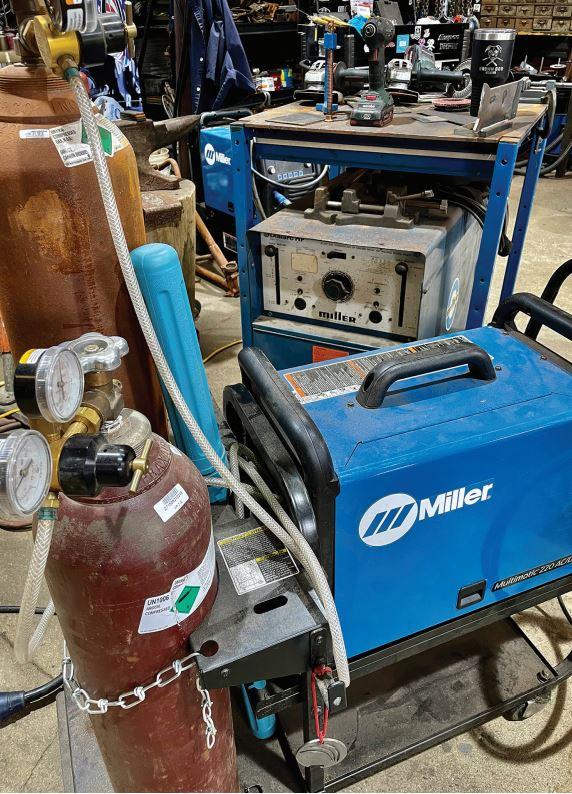Owner, Brown Dog Welding
- FMA
- The Fabricator
- FABTECH
- Canadian Metalworking
Categories
- Additive Manufacturing
- Aluminum Welding
- Arc Welding
- Assembly and Joining
- Automation and Robotics
- Bending and Forming
- Consumables
- Cutting and Weld Prep
- Electric Vehicles
- En Español
- Finishing
- Hydroforming
- Laser Cutting
- Laser Welding
- Machining
- Manufacturing Software
- Materials Handling
- Metals/Materials
- Oxyfuel Cutting
- Plasma Cutting
- Power Tools
- Punching and Other Holemaking
- Roll Forming
- Safety
- Sawing
- Shearing
- Shop Management
- Testing and Measuring
- Tube and Pipe Fabrication
- Tube and Pipe Production
- Waterjet Cutting
Industry Directory
Webcasts
Podcasts
FAB 40
Advertise
Subscribe
Account Login
Search
Metal fabricators, don’t let your shop become a time capsule
Why job shop and fab shop owners should freshen up their set-up
- By Josh Welton
- August 21, 2022
- Article
- Shop Management
As a factory/shop rat, I love the industrial scene. Hammers banging, grinders revving, welders buzzing, wrenches click-clacking—I’m here for it. I was 18 when I first set foot into a Steelcase plant, and I can still remember the awe of experiencing the giant presses firing up and feeling the earthquakes as they stamped metal. And it still grabs when me entering a friend’s hot rod shop as the air tool sounds and classic rock echo off the four walls.
Through both my journey across the blue-collar American landscape and my odyssey through Detroit’s manufacturing scene, I’ve observed how industrial shops often become time capsules. From the workforce to the equipment, so much of their practices and processes get stuck in whatever era the shop opened or the current boss/lead started.
I believe that a good mix of experienced employees and young blood needs to exist for a place to stay operating at a level as optimal as the era allows. Let’s focus on welding and fabrication, for obvious reasons.
Technology changes as quickly as the clock tick tocks, and the welding and fabrication sectors are no exception. Just in my career, we’ve gone from huge transformer-driven machines to light inverter-based machines; a choice of (basically) two types of TIG torches and traditional cups grew to an ever-growing niche market of specialized TIG torches and consumables; GMAW-P went from being just a heavy-industry process to readily accessible for any small shop; and automated robotics went from cutting edge to now almost necessary for even a tiny manufacturing operation.
I can’t think of many friends that had some type of CNC cutting operation 10 years ago, but now I can’t throw a rock without hitting a garage with a computer-controlled cutting table, 3D printer, or both.
The game hasn’t just changed, it is change. That’s why an event like FABTECH remains critical, why the spectrum of who FABTECH is for has evolved. It is so important to stay up on what’s new or about to be new!
In some cases, it might be practical to stick with the status quo. If you have a small shop with well-maintained machines, skilled fabricators, and an unchanged job scope, the cost of a new welding machine, fancy equipment, and extra training might not make sense. But to make that call without knowing what else is out there is a mistake. What if a weldment you’ve been short arcing for 30 years could be built with pulse? You can dial it in to weld faster and more efficiently with better quality and less cleanup. You’d have to do your own math, but the time you save could pay for a new machine in short order.
I’ve found myself in a situation many times where the shop I’m working in might as well have the calendar stuck on whatever day the shop was built. The powers that be did their research during the original shop fit-up, and they even went state of the art … for the time. But once in place, change is difficult. At first glance, nobody wants to spend money replacing machinery that works or is a proven process. The problem is when a competitor opens an operation and builds the same thing but with the most advanced machines and techniques. Suddenly they can undercut you because they run more efficiently.
Yet it isn’t about just keeping tools fresh. People need continuous education to stay sharp as well. The best athletes train every single day in concert with the latest proven methods to run faster, leap farther, and lift heavier. Analytics are used in every facet of sports to create more effective players. Why can’t we approach welding like this? (I suppose one reason is when an athlete improves, they see a direct and rising correlation in their bank account, but when a welder becomes more efficient, only the employer gets richer. I can think of one way to remedy that. Pardon my digression.)
Another shop I worked at acquired new technology but skimped on training its workers. When Miller unleashed its Dynasty series a few decades ago, this shop went from the transformer-based Syncrowave welding machines to the inverter-based Dynasty to handle TIG duties. To go from 60 Hz to having a full range of high frequency and wave manipulation was a game-changer.
The young guys coming up learned on the inverter-based machines. But for the old-timers, it was intimidating to have this loud box full of angry bees suddenly become their main tool. It led to some confusion, like when one guy told me I was “wasting time” cleaning aluminum because “these new machines have that high frequency that cleans it for you!” Or some of them would just set the machine up to mimic a transformer’s performance as opposed to learning the benefits of the machine’s adjustability.
My CWI/CWE/CWS friend Nate Bowman (@weldscientist) goes into businesses to evaluate workers, equipment, and processes and find ways to improve the workflow and costs. I’ve done a bit of this locally and concur with Nate when he says, “I have companies that I’ve gone into where I could save them $500,000 a year, but they say, ‘Yeah, I get it, we see this. I’m a business owner and this makes sense, but we can’t get our welders to listen to what you have to say because they are so stuck in their ways!’”
Just because we have the answers doesn’t mean that people are willing to make a change. I figured this out, too, given that so many things right now are run by people five to 10 years away from retirement. They don’t want to spend time learning something new.
This isn’t to say the overall workforce is aging because it is not. But when all your decision-makers are high in seniority and who have only known a certain way for 20 to 40 years while the younger workers are disregarded, it can be difficult to evolve. In my experience, the best shops employ folks with a nice mix of ages and backgrounds. The shop I currently work at has struggled at times to improve methods and machines under certain leadership. But as new, fresh voices with clear eyes and open minds join the team and rise in authority, it becomes easier to move forward with novel ideas.
Nate once asked me, “Isn’t it insane when every couple of years Miller, Lincoln, ESAB, Fronius, and OTC come out with new waveforms, new machines, better wire, and better technology to do the same thing, but people want to stick with the way they have always done it?!”
Yes, it is insane. The solution must be some sort of full-spectrum approach: The constant evaluation of process, equipment, and manpower is the way to become and remain as efficient as possible.
About the Author

About the Publication
subscribe now

The Welder, formerly known as Practical Welding Today, is a showcase of the real people who make the products we use and work with every day. This magazine has served the welding community in North America well for more than 20 years.
start your free subscription- Stay connected from anywhere

Easily access valuable industry resources now with full access to the digital edition of The Fabricator.

Easily access valuable industry resources now with full access to the digital edition of The Welder.

Easily access valuable industry resources now with full access to the digital edition of The Tube and Pipe Journal.
- Podcasting
- Podcast:
- The Fabricator Podcast
- Published:
- 04/16/2024
- Running Time:
- 63:29
In this episode of The Fabricator Podcast, Caleb Chamberlain, co-founder and CEO of OSH Cut, discusses his company’s...
- Industry Events
16th Annual Safety Conference
- April 30 - May 1, 2024
- Elgin,
Pipe and Tube Conference
- May 21 - 22, 2024
- Omaha, NE
World-Class Roll Forming Workshop
- June 5 - 6, 2024
- Louisville, KY
Advanced Laser Application Workshop
- June 25 - 27, 2024
- Novi, MI


































